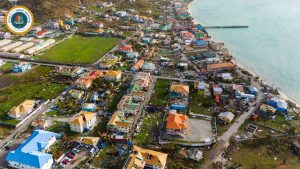 The St. Vincent and the Grenadines government says Hurricane Beryl which struck the island on July 1 this year, left EC$800 million(one EC dollar=US$0.37 cents) in damage.
The St. Vincent and the Grenadines government says Hurricane Beryl which struck the island on July 1 this year, left EC$800 million(one EC dollar=US$0.37 cents) in damage.
Finance Minister Camillo Gonsalves, speaking on a radio programme, told listeners that the climate change conversation includes loss and damage.
“The damage is what the storm blew down. That’s what was mashed up. The losses are money that would have been made,” he said, adding that the loss includes the impact that Union Island resident Abdon Whyte had spoken about on the same programme regarding the impact on the hospitality and fisheries sectors because of damage to their assets.
“Those are losses that are in addition to the $800 million that I’m talking about,” Gonsalves said.
“Where I sit now as Minister of Finance, St. Vincent Grenadines does not today have the EC$800 million to replace everything that has been damaged. I hear a lot of talk about how much money we have, and money everywhere, and money spending everywhere, $800 million in damage.”
Gonsalves noted that Parliament approved an EC$136 million supplementary budget to address the immediate aftermath of the storm “and some of that budget wasn’t dealing with loss, it wasn’t dealing with damage, it was dealing with income support and this kind of thing.
“So, we have some money from the Saudis; we have some money from the World Bank, but we still have a gap in damages in excess of EC$200 million, probably in excess of EC$300 million, and so we don’t have all the money today that we will need to put everything back together, which is why, yes, local consumption, local activity, taxes, the buoyancy of the GDP (gross domestic product) is important.”
Gonsalves said that the country will not get out of the hole that the cyclone created without concessional financing and grants “from the outside world.”
“And so that’s why we have reprogrammed money that we were going to use to build the hospital,” he said, referring to US$80 million loan that was redirected to hurricane relief.
“We’ve shifted the World Bank money to storm relief, and now we’re getting the construction money for the hospital from Taiwan,” he said, referring to the US$125 million that the government is borrowing from Taipei this year.
He said the government plans to rebuild over the next two years 1,500 houses damaged by Hurricane Beryl while trying to maintain the “very delicate balance between rebuilding quickly and rebuilding most effectively”.
Gonsalves said 4,000 houses have to be addressed, “some of them were … destroyed. Those are ones we call level 3 and level 4, and some lost a few sheets of galvanise. Those are called level 1 and level 2,” he said,
“As we enter this reconstruction phase, there’s a very delicate balance between rebuilding quickly and rebuilding most effectively, because a lot of the houses that were damaged, on further inspection, could have been more resiliently-built in the first place,” he added.
The Finance Minister said the government does not want to tack on galvanise sheets on poorly constructed houses.
“You want to make sure that when the next storm comes, it is less likely that they lose those few sheets of galvanise.”
Hurricane Beryl damaged over 90 per cent of buildings in the Southern Grenadines according to government figures. However, it left significant damage in other parts of the country, including Bequia and parts of St Vincent.
Gonsalves said that in St Vincent, informal settlements were hardest hit, adding that the houses that were destroyed tended to be ones that were not structurally sound.
“And the important thing for those houses and for those people is not just that we give them … a sling of cement and 30 sheets of galvanise and a few pieces of lumber,” he said.
“Is that we get those houses to be rebuilt in a way that will make them more resilient going forward so that when the next storm comes, we’re not going back to those same families to try to give them a few more pieces of galvanise, a few more a few more sacks cement.
“So, there’s a balance here because, obviously, it’s always easiest to build back exactly what was there before. But we’re trying to build back with some eye to the future as well as to the immediate needs so that we can help these houses build back in a way that they’ll be more resilient going forward.”
He said this is going to be “a tension” that has to be navigated during the construction phase.
Gonsalves noted that the law does not require the government to rebuild houses damaged by natural hazards and that it is a fairly recent phenomenon in St Vincent and the Grenadines’ history that a government would rebuild such homes.
“We’re proud that the people see the government as having a role in their resilience building and their rehabilitation,” he said.
“But think of Soufriere (volcano) in 1979 or think of disasters prior to the last 15 years, there was not an expectation that the state would build back your house, give you income support, give you, essentially, unemployment support during that period, that they would give the farmers seeds and replant their fields and plough their fields for them. These are all things that a socially responsible government does.”
